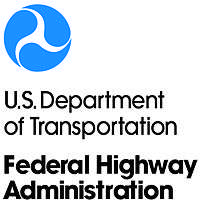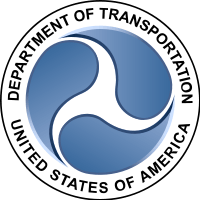Federal Highway Administration
|
Federal Highway Administration logo | |
| Agency overview | |
|---|---|
| Formed | April 1, 1967 |
| Preceding agency |
|
| Jurisdiction | United States Government |
| Headquarters | Washington, D.C. |
| Agency executives |
|
| Parent agency | US Department of Transportation |
| Website |
www |
The Federal Highway Administration (FHWA) is a division of the United States Department of Transportation that specializes in highway transportation. The agency's major activities are grouped into two "programs," the Federal-aid Highway Program and the Federal Lands Highway Program. Its role had previously been performed by the Office of Road Inquiry, Office of Public Roads and the Bureau of Public Roads.
History
Background
The organization has several predecessor organizations and a complicated history.
The Office of Road Inquiry (ORI) was founded in 1893. In 1905 that organization's name was changed to the Office of Public Roads (OPR) which became a division of the United States Department of Agriculture. The name was changed again to the Bureau of Public Roads in 1915 and to the Public Roads Administration (PRA) in 1939. It was then shifted to the Federal Works Agency which was abolished in 1949 when its name reverted to Bureau of Public Roads under the Department of Commerce.
With the coming of the bicycle in the 1890s, interest grew regarding the improvement of streets and roads in America. The traditional method of putting the burden on maintaining roads on local landowners was increasingly inadequate. New York State took the lead in 1898, and by 1916 the old system had been discarded everywhere area. Demands grew for local and state government to take charge. With the coming of the automobile after 1910, urgent efforts were made to upgrade and modernize dirt roads designed for horse-drawn wagon traffic. The American Association for Highway Improvement was organized in 1910. Funding came from automobile registration, and taxes on motor fuels, as well as state aid. In 1916, federal-aid was first made available to improve post-roads, and promote general commerce. Congress appropriated $75 million over a five-year period, with the Secretary of Agriculture in charge through the Bureau of Public Roads, in cooperation with the state highway departments. There were 2.4 million miles of rural dirt rural roads in 1914; 100,000 miles had been improved with grading and gravel, and 3000 miles were given high quality surfacing. The rapidly increasing speed of automobiles, and especially trucks, made maintenance and repair high-priority item. Concrete was first used in 1893, and expanded until it became the dominant surfacing material in the 1930s. [1][2]
Federal aid began in 1917. From 1917 through 1941, 261,000 miles of highways were built with federal aid, and cost $5.31 billion. Federal funds totaled $3.17 billion, and state-local funds were $2.14 billion.[3]
Creation
The FHWA was created on October 15, 1966.
In 1967 the functions of the Bureau of Public Roads were transferred to the new organization.
It was one of three original bureaus along with the 'Bureau of Motor Carrier Safety' and the 'National Highway Safety Bureau' (now known as National Highway Traffic Safety Administration).[4]
Functions
The FHWA’s role in the Federal-aid Highway Program is to oversee federal funds used for constructing and maintaining the National Highway System (primarily Interstate Highways, U.S. Routes and most State Routes). This funding mostly comes from the federal gasoline tax and mostly goes to state departments of transportation. FHWA oversees projects using these funds to ensure that federal requirements for project eligibility, contract administration and construction standards are adhered to.
Under the Federal Lands Highway Program (sometimes called "direct fed"), the FHWA provides highway design and construction services for various federal land-management agencies, such as the Forest Service and the National Park Service.
In addition to these programs, the FHWA performs and sponsors research in the areas of roadway safety, congestion, highway materials and construction methods, and provides funding to local technical assistance program centers to disseminate research results to local highway agencies.
The FHWA also publishes the “Manual on Uniform Traffic Control Devices” (MUTCD), which is used by most highway agencies in the United States. The MUTCD specifies such things as the size, color and height of traffic signs, traffic signals and road surface markings.
Organization
The Federal Highway Administration is overseen by an Administrator appointed by the President of the United States by and with the consent of the United States Senate. The Administrator works under the direction of the Secretary of Transportation and Deputy Secretary of Transportation. The internal organization of the FHWA is as follows:
- Administrator
- Executive Director
- Office of Infrastructure
- Office of Research, Development, and Technology
- Office of Planning, Environment, and Realty
- Office of Policy and Government Affairs
- Office of the Chief Financial Officer
- Office of Administration
- Office of Operations
- Office of Safety
- Office of Federal Lands Highway
- Office of Chief Counsel
- Office of Civil Rights
- Office of Public Affairs
- Executive Director
Administrators
|
|
Current:
- Administrator: Greg Nadeau
- Deputy Administrator: vacant
- Executive Director: Jeffrey F. Paniati
See also
- Federal Motor Carrier Safety Administration
- Highway Gothic
- Title 23 of the Code of Federal Regulations
- Intelligent Transportation Systems
- Intelligent Transportation Systems Institute
- National Transportation Communications for Intelligent Transportation System Protocol (NTCIP)
- U.S. Department of Transportation
References
- ↑ Harold U. Faulkner, The Decline of Laissez Faire, 1897-1917 (1951) pp 233-36.
- ↑ Charles Lee Dearing, American highway policy (1942).
- ↑ The total GNP at current prices, 1917 through 1941 = $2,227.2 billion, so these roads = 5.32/2.227.2 = 1/4 of 1% of GNP. US Bureau of the Census, Historical Statistics of the United States (1976) pp 224, 711, series F1, Q 64-Q68
- ↑ "Public Roads - Highway Existence: 100 Years and Beyond, Autumn 1993". fhwa.dot.gov.
External links
| Wikimedia Commons has media related to Federal Highway Administration. |

